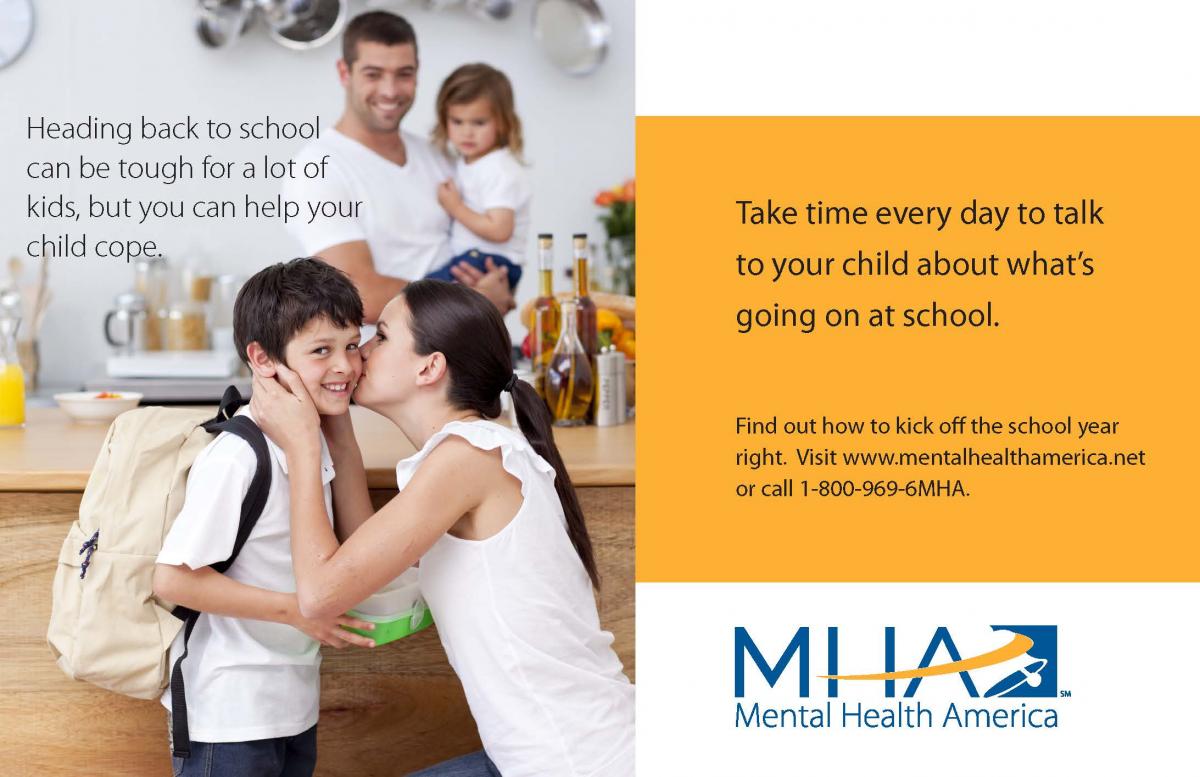You are here
Back To School 2014
| Survey for Adults |
Survey for Youth |
With new teachers and classmates, bigger classrooms, new routines and more schoolwork, the beginning of a new school year can be an exciting and stressful time for children. This time can be particularly overwhelming for children who are facing major transitions such as moving to a new city, or entering elementary or middle school for the first time. As a parent there are important steps you can take to support your child as he or she heads back to school.

Establish an early routine
- Planning for a good school year starts in the summer. Begin establishing a "back to school" routine at least two weeks prior to school starting to minimize stress and help with the transition.
- Adjust their bedtime schedule. Many kids (including teens) need as many as 9 or more hours of sleep. Adjusting their schedule ahead of time will help your child be ready when school starts.
- Promote good eating habits. Plan for ways to ensure your child gets a healthy breakfast to help prepare them for the school day. If you pack your children's lunches, go grocery shopping with them and allow them to pick out healthy foods they’ll enjoy. Kids tend to eat what they’ve picked out themselves.
Get acquainted with the school
- See if your child is interested in visiting the school prior to the first day. Take a walk around the school with your child to locate his or her classrooms, lunchroom, playground and restrooms. If you can’t visit, take a virtual tour on the school’s website. There may be photos of the classroom, playground, school staff, required school supplies, schedules, etc. This will help keep your child from feeling lost on the first day.
- Engage with school staff. Identify school functions or parent volunteer opportunities to stay involved in your child's education.
Provide emotional support
- Talk to your child about expectations for the upcoming school year. Ask about specific concerns they might have about the new school year.
- If you establish rules, make sure they are simple, age appropriate, clear, and can be consistently enforced. Introduce them before the school year starts, and try not to change rules often.
- Spend time each day talking to your child. Try to use open ended questions. We all have asked, “How was school today?” Our children often respond with, “Fine” or “Good.” Try asking, “What was the most exciting thing about today? What was the most stressful?” Remember to share about your life too. Creating an open dialogue is about creating healthy habits and practices.
- Praise and encourage your child to become involved with school activities and to try new things. Encourage your child to try to make new friends and to be a friend. School is a "social hub" that can be a very lonely place without a friend or two. Encourage them to reconnect with a friend before the start of school. Talk about strategies for making new friends.
Identify additional mental health needs
- Know the signs of bullying. Bullying can take the form of direct bullying such as pushing, kicking, teasing, name-calling, destroying belongings as well as indirect action such as leaving someone out of a group, spreading rumors and cyber bullying.
- If your child is the bully or being bullied, swift action involving school staff is necessary.
- Remember to let your child know that it's normal to feel nervous about the start of school. For parents of younger children, suggest that your child take a family photo or special object (with permission from school) to school to make his or her surroundings more comfortable.
- Anxiety and stress about starting school is normal for a child and usually passes within the first few days or weeks. If your child continues to seem anxious or stressed, it may be time to seek help.
- Be proactive in learning about how your child is developing physically, socially and emotionally. If you are aware of what's typical behavior and thoughts for your child, you will be able to tell more readily when things change. Recognizing sudden changes in behaviors are useful in early intervention of emotional needs.
- Talk to your child's teacher, other classroom-based staff as well as your pediatrician about what you can do as a parent. If problems persist, consider getting a referral to a trained and qualified mental health professional.
Know that your child's mental health is just as important as their physical health; your involvement will help him or her develop a healthier life.
In addition, we have developed various Back to School materials that address these important issues in schools and the community. Feel free to download, print, and share them!
List of Back to School Materials
- Children’s Mental Health Matters: Promoting Children’s Mental Health
- Children’s Mental Health Matters: Take a Closer Look
- Bullying: Tips for Parents
- Bullying and LGBT Youth
- What to Do If You Are Being Bullied
- Healthy Mental and Emotional Development
- Parent/Advocate Back to School Checklist
For your older children, we also have developed Back to Campus materials and accompanying toolkit which provides you and your young adult with helpful information and resources.
Additional resources
Further information on child development, mental and physical wellness and development, and childhood related issues can be obtained from the following resources:
American Academy of Child and Adolescent Psychiatry
202-966-7300
www.aacap.org
Center for Early Childhood Mental Health Consultation, Georgetown University Center for Child & Human Development
http://ecmhc.org/TTYC/index.html
Center for Parent Information and Resources
http://www.parentcenterhub.org/
Food and Nutrition Information Center (USDA)
http://fnic.nal.usda.gov/lifecycle-nutrition/child-nutrition
301- 504-5414
National Federation of Families for Children's Mental Health
240-403-1901
http://www.ffcmh.org/
ffcmh@ffcmh.org
National PTA: Emotional Health
http://www.pta.org/emotionalhealth
1-800-307-4782
info@pta.org
School Family (Parent Online Resources)
http://www.schoolfamily.com/
Stop Bullying
http://www.stopbullying.gov/







this page